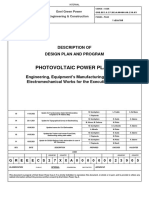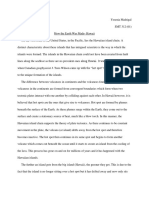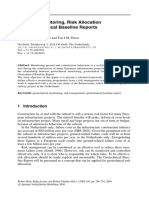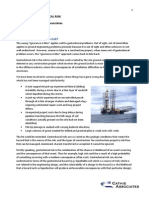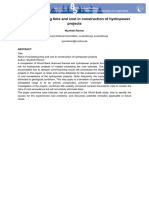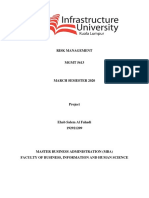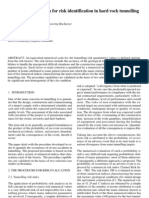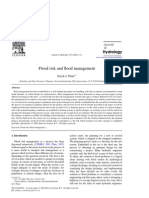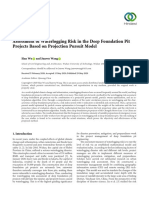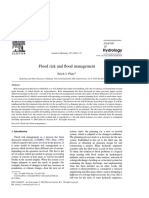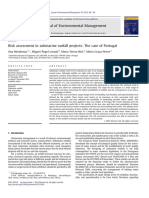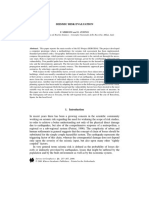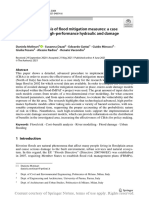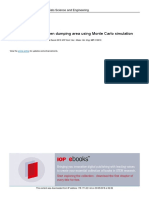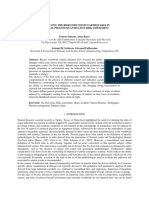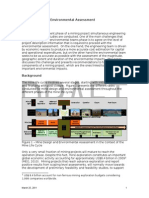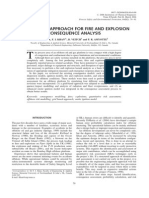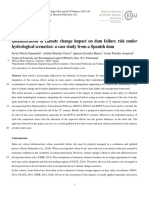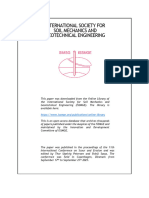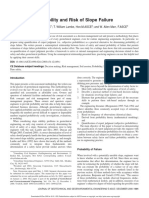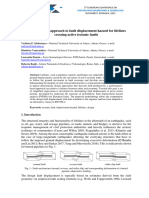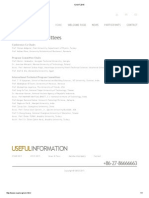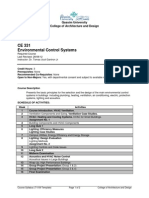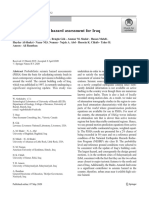On The Development of A Risk Management Plan For Tunnelling: Geodata Spa Corso Geodata Spa Corso
On The Development of A Risk Management Plan For Tunnelling: Geodata Spa Corso Geodata Spa Corso
Uploaded by
Harold TaylorCopyright:
Available Formats
On The Development of A Risk Management Plan For Tunnelling: Geodata Spa Corso Geodata Spa Corso
On The Development of A Risk Management Plan For Tunnelling: Geodata Spa Corso Geodata Spa Corso
Uploaded by
Harold TaylorOriginal Title
Copyright
Available Formats
Share this document
Did you find this document useful?
Is this content inappropriate?
Copyright:
Available Formats
On The Development of A Risk Management Plan For Tunnelling: Geodata Spa Corso Geodata Spa Corso
On The Development of A Risk Management Plan For Tunnelling: Geodata Spa Corso Geodata Spa Corso
Uploaded by
Harold TaylorCopyright:
Available Formats
On the development of a risk management plan for tunnelling
P. Grasso Geodata SpA Corso M.A. Mahtab Geodata SpA Corso G.S. Kalamaras Geodata SpA Corso H.H. Einstein Dept. of Civil Engineering, MIT
ABSTRACT: The principal risks in tunnelling projects generally derive from the uncertainties and hazards associated with the geological and construction conditions or parameters. Materialization of these risks has a negative impact on project performance, with respect to time, cost, safety, and environmental aspects. A risk management plan (RMP) needs to be followed for mitigating these risks. The RMP consists of four essential elements: risk identification, risk quantification, risk response development, and risk response monitoring. The risks influenced by the inadequacy of geotechnical investigations, the consequences of a wrong choice of one or more components of the construction scheme, and the impact of a problematic accident during construction/operation of the project. The tool recommended for use in assessing the risks is a software package called Decision Aids in Tunnelling (DAT). In this paper the main emphasis of the use of RMP is on the geoengineering of the discussed projects. 1 INTRODUCTION The need for development of a risk management plan (RMP) for tunnelling is underlined by the e xperience of Geodata associated with more than 1200 km of tunnelling in various types of conditions. This paper focuses on the development of a RMP through elaboration of the four major components: identification, quantification, response development and response monitoring of risk. Since the number and the extent of the possible risks involved in tunnelling are too large to be covered in one article, this paper will use the risk of collapse in a tunnel as the framework for demonstrating the development and the use of RMP, with reference to two case histories, each having the risk of collapse generated by a different problem. 2 RISK MANAGEMENT PLAN
2.1 Risk Identification Risk identification is the central issue and starting point for the RMP. In the literature, risk is generally defined as the product of the probability of occu rrence of a problem, i.e. hazard, and of the resulting losses that are normally translatable into economic and health-and-safety impacts. A problem is defined here as an unforeseen negative condition in the assumed state of a variable in tunnelling. (Note that the uncertainty in a variable, though neither positive nor negative, can influence the magnitude of the negative condition.) Some of the variables generally associated with a problem are listed below: - The extent of site investigation and the knowledge of ground behavior (including stability and presence of water and gas): The uncertainty in the quantification of the geologic variab les (and an assessment of ground behavior) is directly related to the extent of site investigations. Probabilistic project cost-benefit analysis can assist the process of defining the extent of a site investigation scheme also taking into consideration the reliability of an explora-
It is noted that the data used for the case histories involves the removal of some sensitiv e issues, which cannot be disclosed without the approval of the Client. Therefore, the examples use some assumptions, which are appropriate and correspond to our experience.
tion technique in defining with certainty the actual geologic conditions (Einstein et al., 1977). Constructability and adaptability of the design and of the construction method to diverse g eomechanical conditions: These problems are linked with the information on the expected ground behavior, experience of the Designer and/or Contractor, and the contractual constraints. Political and social conditions:
repeated accidents on the same project. These augmented effects can also be represented by a triangular distribution. Figure 1. Distribution of the number of geologic accidents for a 20km-long tunnel segment as defined by the Poisson model The most efficient tool to our knowledge for the assessment of risk is the system called Decision Aids for Tunnelling (DAT) which was originally developed through a cooperation between Massachusetts Institute of Technology and Ecole Polytechnique Fdrale de Lausanne (Einstein et al, 1992). Geodata provided additional contributions to the DAT in the form of practical applications. The DAT allows one to describe the effect of geologic/geotechnical, construction, and other uncertainties and to determine the effect of these uncertainties on the construction cost and time in the form of cost/time distributions or scatter-diagrams, as illustrated in Figure 2.
Global cost [units]
1.8 1.6 1.4 1.2 1.0 0.8 0.6 6.0 7.0 8.0
These problems are difficult to quantify, but can assume significant proportions. 2.2 Risk Quantification In the field of tunnelling, risk quantification is based on a combination of objective (statistical) and judgmental (experts opinion) approaches. This is true for quantifying both components of risk, the probability of occurrence of a problem and the resulting losses. Judgmental quantification becomes necessary when the nature and extent of the data is not susceptible to statistical manipulation. In addition, there are occasions when a large set of data is available, but the statistical analysis of the data cannot identify the specific problem, such as a fault or a lens of cohesionless material. Even though any two tunnels may not have similar geologic and construction variables, the experience related to certain problems may still provide a good basis for allocating risk in a general sense. In this context, the technique of organizing workshops of experts for evaluation of the data can provide a realistic perspective on the risks. The following discussion is related to the spec ific case of quantifying the risk of collapse in a 20kmlong segment of an Alpine tunnel. The Poisson distribution was used to quantify the probability of occurrence of a discrete event. A discrete event is defined here as the presence of a water-bearing shear zone of limited extent. Assuming that the probability of encountering a discrete event every 10m of tunnel excavation is 0.1%, the resulting distribution of the number of events along the 20km-long segment is given in Figure 1. When deciding on the economic consequences of recurring, discrete events (e.g., three collapses in a single project), an exponential function is used for representing their effects. This choice is justified by the non -linearity of opportunity costs, the problem of logistics, the higher potential for claims, and the augmented political and social effects arising from
Minimum site investigations Extended site investigations
9.0 10.0 11.0
Project duration [years]
Figure 2. Scatter-diagram of duration and cost of two alternatives of the same project characterized by different extents of investigations
3 EXAMPLE APPLICATIONS 2.3 Development of Response to Risk The response to risks (RR) consists of procedures for managing risks both technically and financially. The technical countermeasures must form an integral part of the overall design. The financial management of risks should include contingency plans and allocation of reserves (Duncan, 1996). The RR should be updated in the course of the project, as a function of the variation in the risk environment. Although a RR is technically indispensable for facing risks, the financial implications of dealing with risks require an a priori definition of specific contractual clauses. Most risks can be, by contractual arrangement, assigned either to the Owner, or to the Contractor, or can be shared between them. In general, forcing the maximum assumption of risk to one side (contractor or owner) is likely to result in high project costs. For example, with regard to ground conditions, the most efficient RR is to adopt risk-sharing approach. Risk sharing should aim at providing an incentive for the timely completion of a project. Some of the principles that can assist in this direction are listed in Grasso et al., 2001. In the example of the tunnel mentioned in Section 2.2 the RR for reducing the risk of time and cost of construction was to extend the site investigations. As illustrated in Figure 2, this RR not only reduced both the time and cost of construction but also introduced a higher degree of confidence in these parameters. 2.4 Monitoring of Response to Risk The objective of monitoring the response to risk is to determine the extent to which the actual response has reduced the specific risk. In the preceding example, two responses to the risk of collapse were made: (1) extending the site investigations during construction and (2) draining and grouting the shear zones in advance. The effectiveness of the RR was monitored by measuring the water inflow and pressure, convergence, and stresses in the lining. The following considerations (Grasso & Xu, 1999) should form an important part of monitoring the response to risk: - Monitoring should not be viewed as an obst acle, but accepted as a necessary ingredient of a safer and more economical construction; - Every parameter selected for monitoring should in fact be critical; every procedure should have a clear and defined purpose; - A clear and timely communication about the results of monitoring is essential. 3.1 Modelling of tunnel collapses which result from unforeseen geologic conditions The example refers to the preliminary study for constructing another Alpine tunnel using both conventional and mechanized excavation techniques. The following process was used in preparing the model: a) The alignment was divided into sections, with each section having the same distribution of g eomechanical conditions. The known fault zones were also defined along the alignment as the zones where the application of special measures would be required. b) Three types of unknown geologic/geomechanical conditions were defined in terms of their specific location and impact: - Shear zones of limited extent, - Shear zones of limited extent, but associated with high water inflows, and - Geomechanics -related hazards (squeezing, rockbursts, time-dependent behavior). An additional condition, termed as unknown condition, was considered to take into account the potential hazards that could not be identified at the time of the study due to the limited experience involving the depth and length of the project. c) A Poisson distribution of the number of possible incidents was defined for each alignment segment as a function of the length of that segment and the probability of occurrence of a single event. The definition of the probability of the event was based on the geologic context and empirical relationships. A customized distribution was assigned to the delay and economic impact. This distribution resembled a truncated, negative-exponential distribution, i.e., a higher probability of small impact and a very small probability for major impact. d) The magnitude of the impact was a function of the configuration of the project at the time of excavation of the tunnel, i.e., presence of an exploration adit, or the second tube (Collomb et al, 2001). e) The system DAT was used to evaluate the cumulative effect of these hazards on the various project alternatives. As Figure 3 indicates, the magnitude of the cost and of the delays can be used a decisive factor in selecting the optimum project alternative, through multicriteria analysis (Kalamaras et al, 2000).
(b)
Construction time
(a)
Duration with problems Duration without problems
Location of the advancing face
Figure 4. Simulated project advance using DAT
(c)
It was noted that the benefits of advancing with open face in CFC zones could not be justified. The following two steps were taken to complete the RMP in this example: (1) The measure introduced for mitigating the risk of construction delays, advanced grouting, was carried out from the surface. (2) The monitoring operations included measurements of deformation, water level, and TBM variables. 4 CONCLUSIONS The use of the RMP should always be given a high priority in all tunnelling projects. The emphasis should be placed on the prevention and the mitigation of the most severe risks. Simulation of the consequences in terms of the time and costs of the project, as is possible by using the DAT, coupled with experience, is an efficient and proven means for a quantitative assessment of risks. A continued application of the approach to an increasing number of projects is expected to enhance its validity and utility.
Figure 3: Distribution of (a) cost, (b) delay, and (c) water inflow resulting from the simulated incidents 3.2 Collapse Due to Construction Methodology This example refers to the construction of a 4.5kmlong shallow tunnel excavated using a TBM that can excavate in both open and closed modes depending on the geotechnical conditions. The alignment was divided into two types of geologic sections: openface compatible (OFC) and closed-face compatible (CFC). Two principal problems were identified, subsidence and collapse. The probability of the problem being present would be greatest if the TBM was used in open mode in the CFC zones. This probability was quantified using Monte Carlo simulation and subsidence formulas. The risk of damage was quantified based on the importance of the structures on the surface and the delay in the project. The overall project risks were quantified using the DAT. An exponential function was used to take into account the increases in the cost and delay in construction arising from repeated occurrence of problems. Figure 4 presents the location of the advancing tunnel face as a function of time as simulated by the DAT. The analysis indicates that the delays in project duration that result from problems can be at least twice as large as the average duration without problems.
5 REFERENCES Collomb D., Kalamaras G. S., Vignat P., & Bochon A., 2001. LGV Lyon - Turin Modlisation probabiliste, de l'incertitude sur les cots et la dure de ralisation du tunnel de base Maurienne Ambin. Proceedings, World Tunnel Congress ITA 2001, Milan. Duncan, W.R.A., 1996. Guide to the Project Management Body of Knowledge. Project Management Institute, Newtown Square, Pennsylvania. Einstein, H.H., Markow, M.Z., & Chew, K. 1977. Assessing the Value of Exploration for Underground Gas Storage Caverns. Proceedings, Rockstore conference. Einstein, H.H., Halabe, V.B., Dudt, J.-P., & Descoeudres, F.P., 1992. Decision Aids in Tunnelling - Principal and Practical Application. Swiss Federal Office of Transportation Project AlpTransit, Lausanne. Grasso, P., Kalamaras, G.S., Xu, S., & M ahtab, M.A., 2001. Project Financing for Long and Deep Tunnels: an Approach Based on Risk Analysis. Proceedings World Tunnel Congress, ITA 2001, Milan. Grasso, P., & Xu, S., 1999. Significance of Predefine of Countermeasures in Observ ational Design. Proceedings, Christian Veder Colloquium. Technical University of Graz. Kalamaras, G.S., Brino, L., Carrieri, G., Pline, C. & Grasso, P., 2000. Application of multicriteria analysis to select the best highway alignment. Proceedings World Tunnel Congress 2000, Durban.
You might also like
- GRE - EEC.S.27.XX.A.00000.00.239.05 - DPP DescriptionDocument64 pagesGRE - EEC.S.27.XX.A.00000.00.239.05 - DPP DescriptionCarla TraistaNo ratings yet
- How The Earth Was Made - HawaiiDocument3 pagesHow The Earth Was Made - Hawaiiapi-312004413No ratings yet
- Matching Monitoring, Risk Allocation and Geotechnical Baseline ReportsDocument6 pagesMatching Monitoring, Risk Allocation and Geotechnical Baseline ReportsAdeshola FunmilayoNo ratings yet
- Managing Geotech RiskDocument7 pagesManaging Geotech RiskJack DoverNo ratings yet
- Geotechnical Risk in Rock Mass Characterisation - A ConceptDocument11 pagesGeotechnical Risk in Rock Mass Characterisation - A ConceptAzeNo ratings yet
- 321 - Risks of Exceeding Time and Cost in Construction of Hydropower Projects - Wynfrith RiemerDocument9 pages321 - Risks of Exceeding Time and Cost in Construction of Hydropower Projects - Wynfrith RiemerMariaNo ratings yet
- RISK MANAGEMENT Project Ehab SalemDocument14 pagesRISK MANAGEMENT Project Ehab Salemoffical padovaNo ratings yet
- A Risk Index Approach For Risk Identification in Hard Rock TunnellingDocument6 pagesA Risk Index Approach For Risk Identification in Hard Rock TunnellingHarold TaylorNo ratings yet
- Using Copulas in Risk AnalysisDocument6 pagesUsing Copulas in Risk AnalysisghourisNo ratings yet
- FloodDocument10 pagesFloodNordiana AbdullahNo ratings yet
- Research Article: Assessment of Waterlogging Risk in The Deep Foundation Pit Projects Based On Projection Pursuit ModelDocument11 pagesResearch Article: Assessment of Waterlogging Risk in The Deep Foundation Pit Projects Based On Projection Pursuit ModelJOSEPH KIWANGONo ratings yet
- Flood Risk and Flood ManagementDocument10 pagesFlood Risk and Flood ManagementSugeeth 107No ratings yet
- Antecedente 2Document10 pagesAntecedente 2JeanOscorimaCelisNo ratings yet
- Nhess 18 2471 2018Document18 pagesNhess 18 2471 2018Kamil IbraNo ratings yet
- Seismic Risk EvaluationDocument13 pagesSeismic Risk EvaluationJulián Felipe FajardoNo ratings yet
- From Earthquake Hazard To Loss EstimatesDocument16 pagesFrom Earthquake Hazard To Loss EstimatesRojina AdhikariNo ratings yet
- Cost-Benefit Analysis of Flood Mitigation MeasuresDocument25 pagesCost-Benefit Analysis of Flood Mitigation Measurescerenkale3434No ratings yet
- Risk Assessment at Open Dumping Area Using Monte CDocument8 pagesRisk Assessment at Open Dumping Area Using Monte CSameer BhatNo ratings yet
- Klein Risk AssessmentDocument12 pagesKlein Risk AssessmentSantosh K SatiNo ratings yet
- Istituto Di Ricerche Sulla Combustione, Consiglio Nazionale Delle Ricerche, Via Diocleziano 328, 80125 Napoli (IT) - E-Mail: Salzano@irc - Cnr.itDocument6 pagesIstituto Di Ricerche Sulla Combustione, Consiglio Nazionale Delle Ricerche, Via Diocleziano 328, 80125 Napoli (IT) - E-Mail: Salzano@irc - Cnr.iterNo ratings yet
- Simplified Procedure For The Seismic Risk Assessment of Unreinforced Masonry BuildingsDocument15 pagesSimplified Procedure For The Seismic Risk Assessment of Unreinforced Masonry Buildingsclashofclans70065No ratings yet
- Mine Design and Environmental DRAFTDocument6 pagesMine Design and Environmental DRAFTBim BoNo ratings yet
- A Grid Based Approach For Fire and Explosion Consequence AnalysisDocument13 pagesA Grid Based Approach For Fire and Explosion Consequence AnalysisMuhammad SuhaibNo ratings yet
- RS Minerve Application HydroelectricDocument31 pagesRS Minerve Application HydroelectricJulio Isaac Montenegro GambiniNo ratings yet
- A Methodology Based On Numerical Models For EnhancDocument23 pagesA Methodology Based On Numerical Models For EnhancUsman Ali KhanNo ratings yet
- New Developments in Scour ModellingDocument16 pagesNew Developments in Scour ModellingMoreNo ratings yet
- Risks Ranking in A Desalination Plant Construction Project With A Hybrid AHP, Risk Matrix, and Simulation Based ApproachDocument13 pagesRisks Ranking in A Desalination Plant Construction Project With A Hybrid AHP, Risk Matrix, and Simulation Based ApproachefeNo ratings yet
- Probability Risk Paper As Published Discussions Updated PlotsDocument24 pagesProbability Risk Paper As Published Discussions Updated PlotsFelipe Ignacio Campos RodriguezNo ratings yet
- Estimation of Design Impact Forces of Debris FlowsDocument9 pagesEstimation of Design Impact Forces of Debris FlowsDproskeNo ratings yet
- Applications of 3D QRA Technique To The Fire-Explosion Simulation and Hazard Mitigation Within A Naphtha-Cracking PlantDocument10 pagesApplications of 3D QRA Technique To The Fire-Explosion Simulation and Hazard Mitigation Within A Naphtha-Cracking PlantypzoNo ratings yet
- Decision Making Under Uncertainty: Applying The Least-Squares Monte Carlo Method in Surfactant-Flooding ImplementationDocument15 pagesDecision Making Under Uncertainty: Applying The Least-Squares Monte Carlo Method in Surfactant-Flooding ImplementationRumi SeifNo ratings yet
- Assessing Failure Probability of Coastal Structures Based On Probabilistic Representation of Sea Conditions at The Structures' LocationDocument21 pagesAssessing Failure Probability of Coastal Structures Based On Probabilistic Representation of Sea Conditions at The Structures' LocationVicky TsoukalaNo ratings yet
- Research Article: A Novel Method For Evaluating Dredging Productivity Using A Data Envelopment Analysis-Based TechniqueDocument23 pagesResearch Article: A Novel Method For Evaluating Dredging Productivity Using A Data Envelopment Analysis-Based Techniqueabidah fitraNo ratings yet
- Nhess 17 781 2017 PDFDocument20 pagesNhess 17 781 2017 PDFAnkush KumarNo ratings yet
- Good Practice GuidelinesDocument2 pagesGood Practice GuidelinesMohammed Ali100% (1)
- Flood Proofing Low-Income Houses in India: An Application of Climate-Sensitive Probabilistic Benefit-Cost AnalysisDocument16 pagesFlood Proofing Low-Income Houses in India: An Application of Climate-Sensitive Probabilistic Benefit-Cost AnalysisNinad SawantNo ratings yet
- Melissianos Et Al. - pr3ECEES2022Document7 pagesMelissianos Et Al. - pr3ECEES2022Rahma GhanemNo ratings yet
- Investigation of Extreme Flood Processes & Uncertainty (IMPACT)Document42 pagesInvestigation of Extreme Flood Processes & Uncertainty (IMPACT)Ross ZhouNo ratings yet
- Risk Management in EPC Contract - Risk Identification: Rahul Bali and Prof M.R ApteDocument6 pagesRisk Management in EPC Contract - Risk Identification: Rahul Bali and Prof M.R ApteAkhileshkumar PandeyNo ratings yet
- Risk/Reliability-Based Hydraulic Engineering Design: Yeou-Koung TungDocument56 pagesRisk/Reliability-Based Hydraulic Engineering Design: Yeou-Koung TungstarykltNo ratings yet
- Risk Assessment For Civil Engineering Facilities: Critical Overview and DiscussionDocument12 pagesRisk Assessment For Civil Engineering Facilities: Critical Overview and Discussionterror_ro533No ratings yet
- Vulnerability Assessment of Tsunami-Affected Inundated Area Using Geospatial Analysis Based Tsunami Run-Up SimulationDocument21 pagesVulnerability Assessment of Tsunami-Affected Inundated Area Using Geospatial Analysis Based Tsunami Run-Up SimulationzarazobellNo ratings yet
- A DBN-based Risk Assessment Model For Prediction and Diagnosis of Offshore Drilling IncidentsDocument33 pagesA DBN-based Risk Assessment Model For Prediction and Diagnosis of Offshore Drilling IncidentsAd IL100% (1)
- Risk Analysis Methods For Pipelines in Niger Delta: Martins - Enyiche@naoc - AgipDocument13 pagesRisk Analysis Methods For Pipelines in Niger Delta: Martins - Enyiche@naoc - AgipsirluuNo ratings yet
- Reliability-Based Design Optimization of A Rubble Mound Breakwater in A Changing ClimateDocument9 pagesReliability-Based Design Optimization of A Rubble Mound Breakwater in A Changing ClimateLuis Carlos EspinozaNo ratings yet
- Practical Case 1Document7 pagesPractical Case 1keron nilesNo ratings yet
- Management of Hydrogeological Risk in Tunnelling Projects: K SrivastavaDocument5 pagesManagement of Hydrogeological Risk in Tunnelling Projects: K SrivastavaChute-NineNo ratings yet
- Pipeline Risk AssessmentDocument6 pagesPipeline Risk Assessmenthengph5730No ratings yet
- 001 - Andersen (2001) - 2 PDFDocument10 pages001 - Andersen (2001) - 2 PDFRima UzbekNo ratings yet
- Current U.S. Army Corps of Engineers' Policy and Guidance For Seismic Design of Dams-Anjana Chudgar and Enrique E. MatheuDocument9 pagesCurrent U.S. Army Corps of Engineers' Policy and Guidance For Seismic Design of Dams-Anjana Chudgar and Enrique E. Matheurajesh005No ratings yet
- Slope Stability Risk Management in Open Pit Mines: December 2015Document20 pagesSlope Stability Risk Management in Open Pit Mines: December 2015rNo ratings yet
- Paper Clagaro PDFDocument8 pagesPaper Clagaro PDFPanos SpNo ratings yet
- Seismic Risk Assessment and Mitigation Analysis of Large Public School Building Portfolio in Metro ManilaDocument26 pagesSeismic Risk Assessment and Mitigation Analysis of Large Public School Building Portfolio in Metro ManilaChin Chiat LimNo ratings yet
- SPE-190638-MS Real World Spill Response Optimisation: Simon Gibbons, ERMDocument16 pagesSPE-190638-MS Real World Spill Response Optimisation: Simon Gibbons, ERMcerpegarNo ratings yet
- Applsci 10 07960Document40 pagesApplsci 10 07960arif budiyonoNo ratings yet
- PHRD Technical PaperDocument12 pagesPHRD Technical PaperLahiru PrasangaNo ratings yet
- Water 12 02395Document17 pagesWater 12 02395Maria StoicaNo ratings yet
- 2013 - Fundamental and Spesific Marine Geohazard AssesmentDocument18 pages2013 - Fundamental and Spesific Marine Geohazard Assesmentfaris nauvalNo ratings yet
- Manual on Climate Change Adjustments for Detailed Engineering Design of Roads Using Examples from Viet NamFrom EverandManual on Climate Change Adjustments for Detailed Engineering Design of Roads Using Examples from Viet NamNo ratings yet
- Assessment of High Wind and External Flooding (Excluding Tsunami) Hazards in Site Evaluation for Nuclear InstallationsFrom EverandAssessment of High Wind and External Flooding (Excluding Tsunami) Hazards in Site Evaluation for Nuclear InstallationsNo ratings yet
- Advances in the iterative coupling between flow-geomechanical simulators: applied to cases with different contour conditionsFrom EverandAdvances in the iterative coupling between flow-geomechanical simulators: applied to cases with different contour conditionsRating: 5 out of 5 stars5/5 (1)
- Experience in the Management of Radioactive Waste After Nuclear Accidents: A Basis for PreplanningFrom EverandExperience in the Management of Radioactive Waste After Nuclear Accidents: A Basis for PreplanningNo ratings yet
- Icaai 2014Document2 pagesIcaai 2014Harold TaylorNo ratings yet
- Icmam 2015 PDFDocument2 pagesIcmam 2015 PDFHarold TaylorNo ratings yet
- Icaat 2015 PDFDocument1 pageIcaat 2015 PDFHarold TaylorNo ratings yet
- RECENT ADVANCES in ENVIRONMENTAL and BIOLOGICAL ENGINEERINGDocument10 pagesRECENT ADVANCES in ENVIRONMENTAL and BIOLOGICAL ENGINEERINGHarold TaylorNo ratings yet
- Course Specification of English 104-Critical ThinkingDocument8 pagesCourse Specification of English 104-Critical ThinkingHarold TaylorNo ratings yet
- ENG 106 NAAB Couse SyllabusDocument4 pagesENG 106 NAAB Couse SyllabusHarold TaylorNo ratings yet
- ENG 106 NCAAA Course Specification, Spring Semester 2012-2013Document9 pagesENG 106 NCAAA Course Specification, Spring Semester 2012-2013Harold TaylorNo ratings yet
- Phy 105 NCAAA Course Specification, 351Document8 pagesPhy 105 NCAAA Course Specification, 351Harold TaylorNo ratings yet
- CE 331 NCAAA Course Specification, Fall Semester 2012-2013 PDFDocument9 pagesCE 331 NCAAA Course Specification, Fall Semester 2012-2013 PDFHarold TaylorNo ratings yet
- NCAAA Course Report Physics 105 351Document6 pagesNCAAA Course Report Physics 105 351Harold TaylorNo ratings yet
- CE 331 Course Syllabus PDFDocument2 pagesCE 331 Course Syllabus PDFHarold TaylorNo ratings yet
- NCAA Course Report in GE 402 351Document6 pagesNCAA Course Report in GE 402 351Harold TaylorNo ratings yet
- NCAAA ENG 106 Instructor Course Report 351Document7 pagesNCAAA ENG 106 Instructor Course Report 351Harold Taylor100% (1)
- Person Details For Maria Ganiron, Philippines, Deaths and Burials, 1726-1957 - FamilySearch PDFDocument1 pagePerson Details For Maria Ganiron, Philippines, Deaths and Burials, 1726-1957 - FamilySearch PDFHarold TaylorNo ratings yet
- Punya Thai-Lao DMR-July2015Document48 pagesPunya Thai-Lao DMR-July2015souvanla2000No ratings yet
- PrayerDocument14 pagesPrayerJaypee CarlNo ratings yet
- District: Bharuch: Geological MapDocument1 pageDistrict: Bharuch: Geological MapIshwarya SNo ratings yet
- GeologicalTimeline PDFDocument2 pagesGeologicalTimeline PDFMel ClancyNo ratings yet
- 170 Analysis of Mayor Zinc Sources in Marine Sediments of The Estuarine Zone in Aysén Fjord, Chile.-2007Document11 pages170 Analysis of Mayor Zinc Sources in Marine Sediments of The Estuarine Zone in Aysén Fjord, Chile.-2007vere blancoNo ratings yet
- Course - Outline - ENV311.3 - Spring 2024Document4 pagesCourse - Outline - ENV311.3 - Spring 2024zaki.farhanNo ratings yet
- Seismic Impact in Peninsula MalaysiaDocument6 pagesSeismic Impact in Peninsula Malaysiajiwa remajaNo ratings yet
- First Report On The Cenozoic Between Cape Town and Elands BayDocument150 pagesFirst Report On The Cenozoic Between Cape Town and Elands BayBobNo ratings yet
- Schwarz Henk I Jes 2005Document19 pagesSchwarz Henk I Jes 2005Jorge CalvaNo ratings yet
- g9 DLL 19 23Document2 pagesg9 DLL 19 23ariane.mirandaNo ratings yet
- 2013 MicropaleontologyDocument152 pages2013 Micropaleontologyilham100% (1)
- Layers of Earth Study GuideDocument2 pagesLayers of Earth Study GuideFritz Ren KeifferNo ratings yet
- Geochronological Data On The Amsinassene-Tefedest Block (Central Hoggar, Algerian Sahara) and Evidence For Its Polycyclic EvolutionDocument14 pagesGeochronological Data On The Amsinassene-Tefedest Block (Central Hoggar, Algerian Sahara) and Evidence For Its Polycyclic EvolutionOmatoukNo ratings yet
- Jurnal Geologi StrukturDocument29 pagesJurnal Geologi StrukturFardinNo ratings yet
- Earth Science (Fresh Water Reservoir)Document13 pagesEarth Science (Fresh Water Reservoir)FedNo ratings yet
- Risk Analysis of Tsunami AcehDocument15 pagesRisk Analysis of Tsunami Acehsekar maharaniNo ratings yet
- Potential Field Methods: Dwa Desa WarnanaDocument17 pagesPotential Field Methods: Dwa Desa WarnanaSugeng KurniawanNo ratings yet
- Geo-Modeling and Analysis of Site Effects in The Area of CologneDocument8 pagesGeo-Modeling and Analysis of Site Effects in The Area of CologneTaulantKarriqiNo ratings yet
- Science DLP Grade 9 Quarter 3Document208 pagesScience DLP Grade 9 Quarter 3Fria mae AbellanoNo ratings yet
- SOP KentDocument2 pagesSOP KentIbrahim HabibNo ratings yet
- Chapter 12 - VolcanoesDocument113 pagesChapter 12 - VolcanoesBrendon GovaNo ratings yet
- Els ST2Document2 pagesEls ST2Shekaina Faith Cuizon LozadaNo ratings yet
- Scopus Preview - Scopus - Earth Systems and EnvironmentDocument1 pageScopus Preview - Scopus - Earth Systems and EnvironmentAnonymous wXoTDHXzNo ratings yet
- 1 - Combined Notes - Engineering Geology and Soil Mechanics - SCH - Chapter 1 & 2Document32 pages1 - Combined Notes - Engineering Geology and Soil Mechanics - SCH - Chapter 1 & 2hessian123No ratings yet
- Paper 01Document17 pagesPaper 01adnan-651358No ratings yet
- Bedforms PDFDocument7 pagesBedforms PDFAgus SetiawanNo ratings yet
- 731 CV PDFDocument12 pages731 CV PDFSanthosh LingappaNo ratings yet
